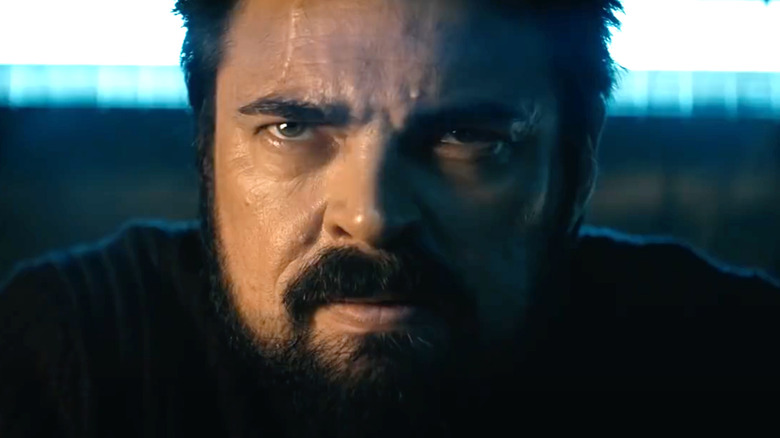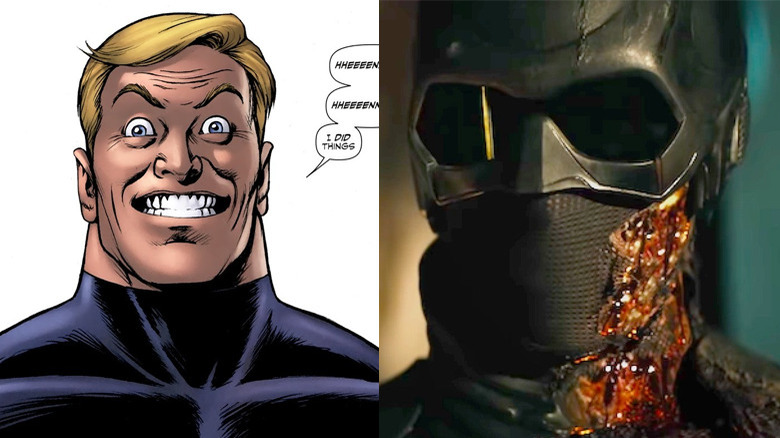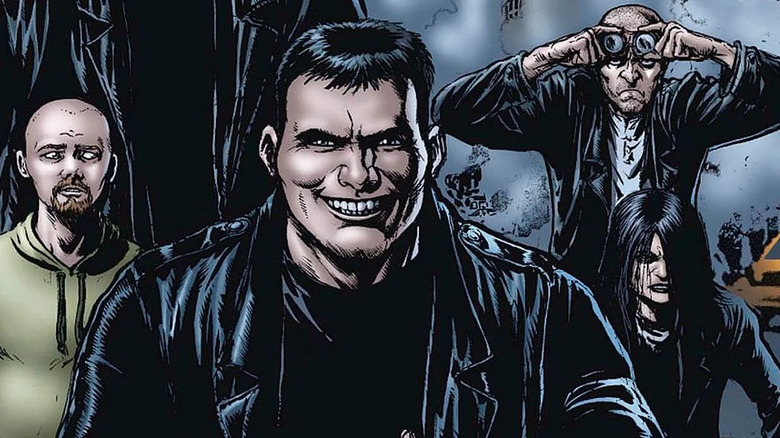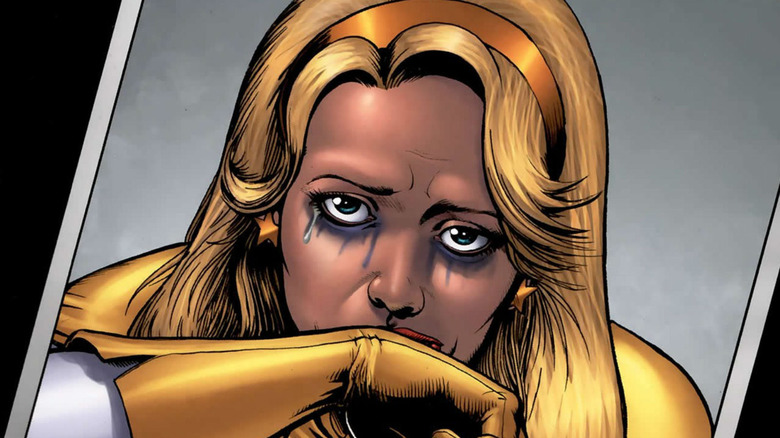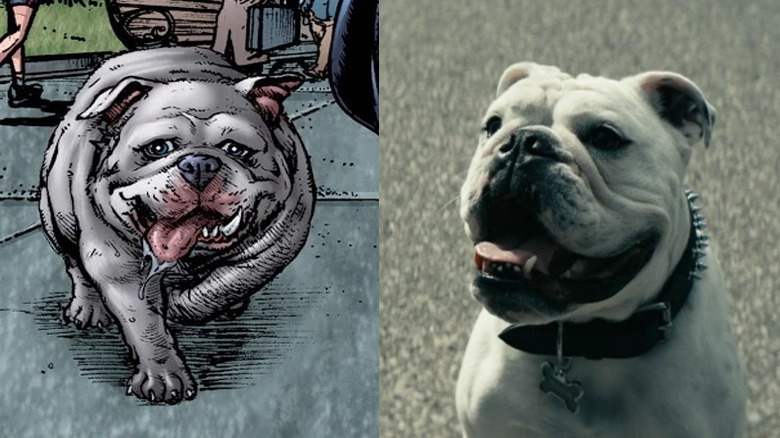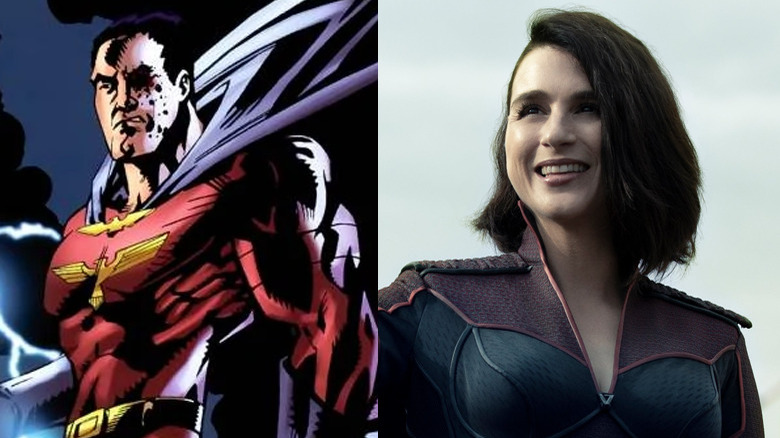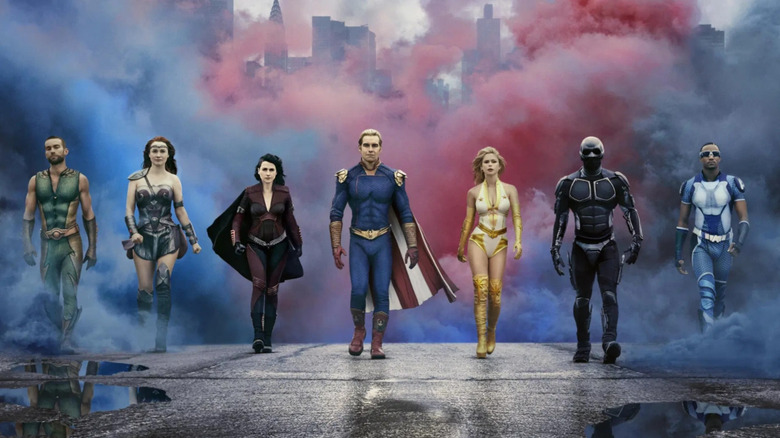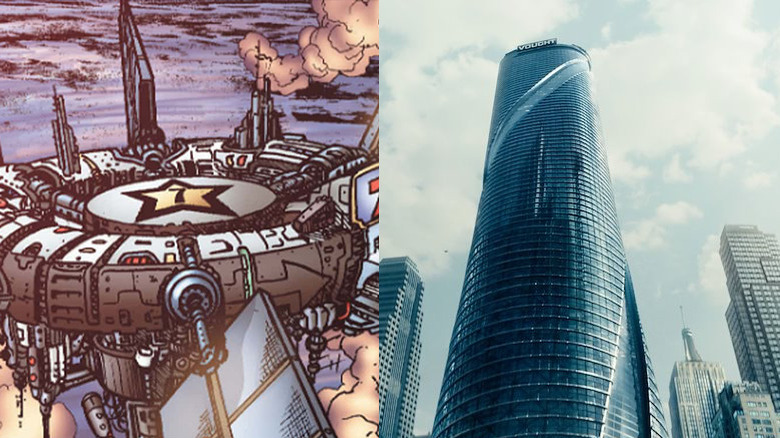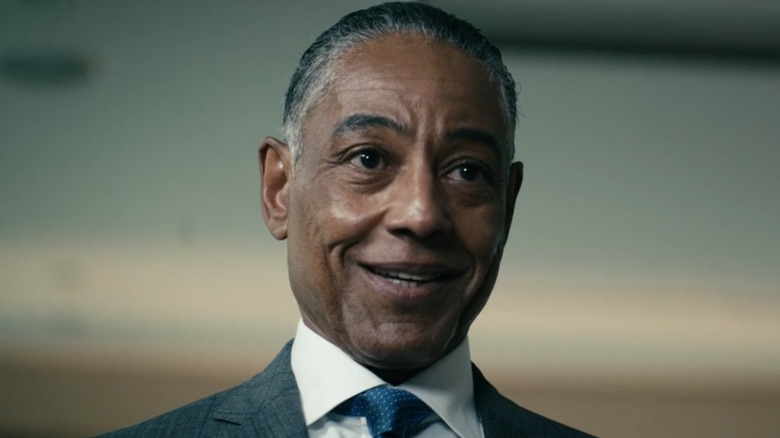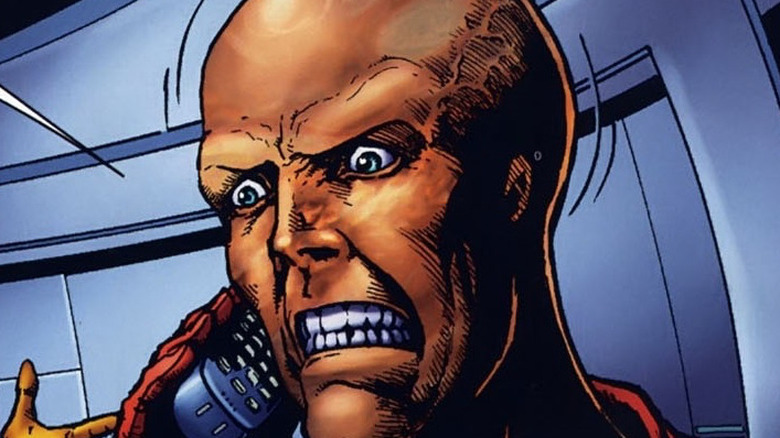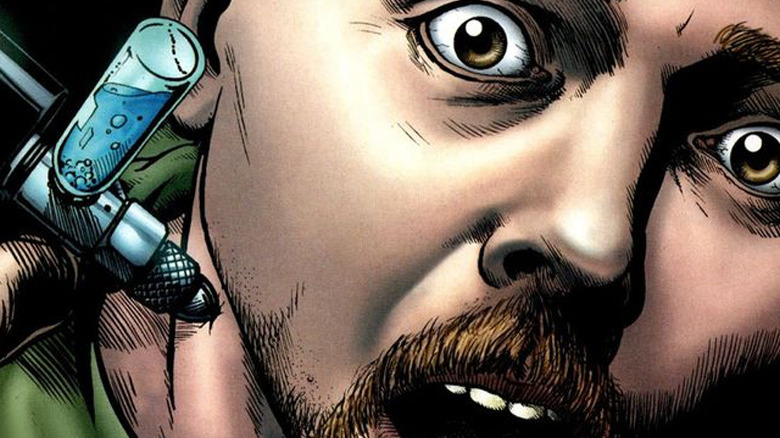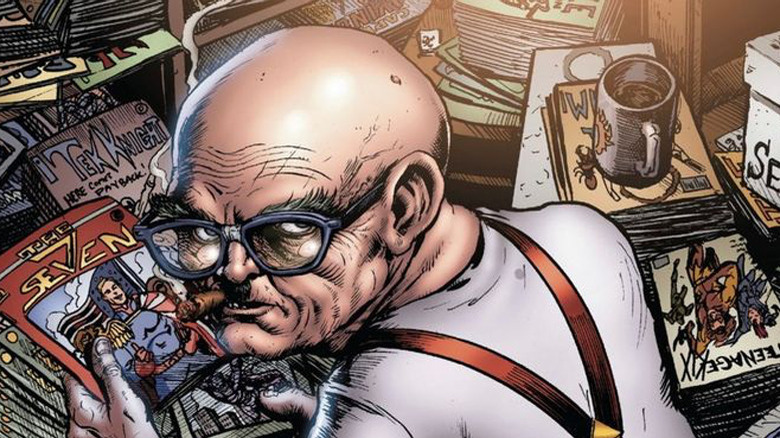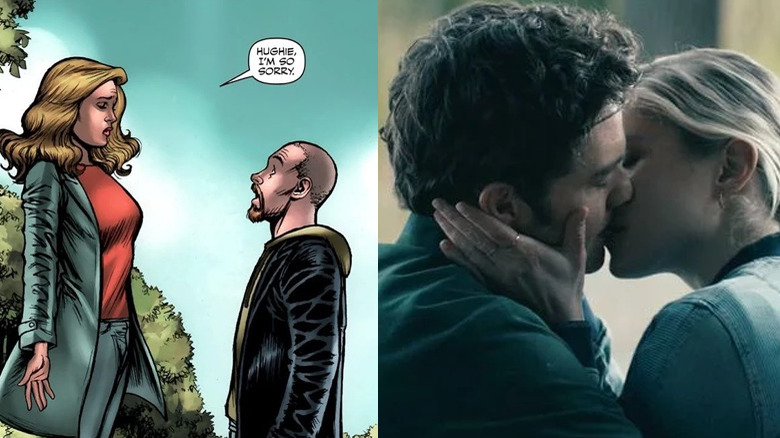12 Differences Between The Boys Comic And The Show
Based on the Garth Ennis-penned comic book series of the same name, "The Boys" portrays a world where superheroes not only exist in large numbers, but are also a massive, multi-million-dollar industry. However, unbeknownst to the general public, superheroes are just as shady, greedy and psychotic as the criminals they put away. That's where the ragtag CIA squad known as The Boys — tasked with keeping tabs on the eclectic superhero community — comes in. This leads to a plethora of shocking revelations, an excessive amount of vulgarity and copious amounts of gore and violence.
That is, however, where the similarities end, as the comic book and the television adaptation are worlds apart in many ways. The comic book, definitely an edgy product of the '00s, is a hyper-cynical, hyper-violent look at superheroes. The show definitely lifts a fair amount of concepts and characters from the book, but is otherwise its own separate entity. Here are just a few of the key differences between "The Boys" comics and the Amazon Prime adaptation — and fair warning, there are spoilers ahead.
Black Noir's identity
The Batman equivalent of the Seven — Vought International's marquee American superhero team — has been (literally) shrouded in mystery since his first onscreen appearance in Season 1. The character has routinely served as a super-powered hit man for the Vought corporation, equal parts fast and deadly. When Black Noir is sent to handle something, there's a good chance one or several people are about to die. Unlike every other member of the Seven, Noir is the only one who wears a mask and full body outfit.
It's very clear that anonymity is important to him, but the major question here is why? The show has yet to unveil Noir's true identity, though there have been a few breadcrumbs scattered around as to who he is. After Hughie and Annie successfully leak the truth of Compound V to the public, we see Noir all alone in a hallway crying. Combine this with his direct line to Stan Edgar, and this has spawned the fan theory that he is Edgar's own son. Whether or not the series takes this route remains to be seen, but it would be very different from the comic series. In the comics, it's revealed that Noir is actually a clone of Homelander made as a contingency if the original ever went rogue. So far the idea of cloning has yet to be introduced in the show, so this feels like it'll be left on the printed page.
The level of violence
This difference isn't so much a plot element or a character change, but more a stylistic departure between page and screen. It's no secret that "The Boys," as far as current television series are concerned, boasts an impressive amount of bloodshed. From A-Train running through Hughie's girlfriend to Translucent having a bomb shoved up his butt and being subsequently splattered — the show doesn't hold back. That being said, the comic book's level of violence makes the television adaptation look like a G-rated kids' movie by comparison. Garth Ennis has never shied away from gratuitous illustrated violence, as quite evident through his other work such as "Preacher" and "Crossed."
From heads being stomped into pulp to graphic, overly-detailed eviscerations to (brace yourselves) babies being eaten, the book is certainly an endurance test. The level of violence, while appropriate for the world established in the book, is far from the most enjoyable content to read. The show, while far from wholesome, definitely knows where to pick its spots in terms of its graphic violence. This stands in contrast to the comic, which more often than not would be sick and twisted simply for the sake of being edgy.
The treatment of Annie aka Starlight
One of the major inciting incidents in the comic and the show revolves around the character Annie January, aka Starlight. In the show Annie is first introduced as a small town superhero who makes it big as The Seven's new recruit. Her big roll-out is given an immense amount of pomp and circumstance, including an appearance by The Deep. The Seven's Aquaman equivalent, who Starlight admits she has a crush on, immediately takes this as a sign to drop his pants. Threatening her newfound position, Annie is coerced by The Deep into performing a demeaning sexual favor for him. The aftermath of Annie vomiting in the bathroom only serves to complete this utterly miserable sequence of events.
While this is certainly sickening in its own right, it doesn't hold a candle to the comic book. In the comic, things play out roughly the same, except it's Homelander himself who gives Annie her inaugural tour. As Annie gushes to Homelander, she turns around to see him with his pants down and quickly flees. This leads to her running into A-Train and Black Noir, who both pull their pants down as well. Compared to the show, which is disturbing in its own right, the comic's portrayal of this scene is far cruder and far more unpleasant.
The absence of Terror
One minor character mostly missing from the show is Billy Butcher's pet and faithful companion, a bulldog named Terror. The aptly named English bulldog is by Butcher's side quite frequently throughout the original comic book's run. Despite Butcher's hyper-violent, hyper-psychotic attitude, he's extremely protective of Terror — one of the few things he has genuine compassion for. More often than not, Butcher gives Terror certain commands, often to crude yet great comedic effect. One of Terror's most noteworthy moments comes when he discretely urinates on Homelander's leg during a confrontation with Butcher.
While not a super-important character, Terror's presence is still consistent and welcome — making his absence from the live-action show a bit mystifying. So far, Terror has only appeared onscreen once in the show's second season, as Billy's dog who's now cared for by his aunt. He's present for a violent fight between Butcher and Noir, thankfully surviving the destructive encounter, and his appearance is fittingly capped off with the mischievous pooch mounting a superhero doll given to him by Butcher. Hopefully in Season 3 we'll see a bit more of Billy Butcher's faithful canine companion.
Stormfront's gender
One of the biggest developments in the show's second season was the introduction of Stormfront, played by Aya Cash. Hired for her ability to rile up the public, Stormfront quickly displays her feelings towards Vought's business and behind-the-scenes practices. Homelander, ever the jealous child, doesn't take too kindly to a new hero stealing his thunder in the public eye. Things take a turn when, during the incident with Kimiko's younger brother Kenji, Stormfront refers to him with a racial slur before snapping his neck. This shocking twist (pun intended) would be one-upped by the reveal that she is actually an immortal, superpowered Nazi. Her defeat at the conclusion of Season 2 still stands as one of the show's most thrilling and cathartic moments.
This stands in contrast to the comics where Stormfront, a male character, is merely presented as a villain of the week. Unlike the show, where Stormfront is left horrifically mutilated, in the comics he is beaten to death by the Boys with baseball bats. The character is still a bigoted, hyper-violent xenophobe, but isn't nearly as fleshed out as his televised female counterpart. It's another example of the show taking a crumb of an idea from the comic and morphing it into its own thing.
The social commentary
This change is one that might not be apparent at first, but provides a definite demarcation between both versions. Each version of "The Boys," amidst the violence and drama, has something to say about two subjects — superheroes and corporations.
It's worth noting just how much writer Garth Ennis' hatred for the superhero subgenre fueled the original comic book, with Ennis stating things like (via LA Times), "They seem to be the perfect fantasy of hope and empowerment for a world that increasingly lacks either." With that nugget of context, it isn't much of a shock just how grotesque, edgy and cynical the comics were. Ennis used the books to critique not only superheroes, but the culture of a George Bush-helmed, post-September 11th America as well.
The show, now set in the 2020s, sets its sights on topics more relevant to this day and age. Not only has the saturation of superheroes in theaters and on streaming platforms increased, but new social issues have emerged as well. In Season 1, the "Me Too" movement was touched upon via the abuse of Starlight by The Deep. Additionally, in Season 2, we saw the likes of the alt-right's online presence discussed through the machinations of Stormfront. It's truly fascinating to see how each version tackles the issues surrounding its release and how each presents its commentary differently.
The Seven's headquarters
Given that The Seven are meant as parallels for the DC Universe's Justice League, their headquarters is obviously an important location. In most versions of the Justice League, they are shown to operate out of the JLA Satellite or the Watchtower. Both locations are equally as grand and magnificent as the heroes they serve. Given that the Seven are intended to be cynical parodies of the League, it makes sense that their command center would do the same. In the comics, the team are shown to operate primarily out of a base that floats in the sky — much like the JLA Satellite.
The show takes this in a different direction, opting to have the Seven operate out of a sizable skyscraper that is Vought's headquarters. This is a direct reference to Avengers Tower, a location used during the early phases of the Marvel Cinematic Universe. It also helps the show's comparatively more grounded tone that the heroes meet in something more believable than a flying sky fortress. It's a small difference, but one that definitely sums up the tonal and visual difference between the two versions.
The importance of Mr. Stan Edgar
It's clear by this point that the Amazon series definitely takes several characters in different directions from their comic book counterparts. Some characters receive a 2020s facelift, while others have their roles tweaked and expanded upon for the show's episodic format. One such character is Mr. Stan Edgar, played by Giancarlo Esposito, better known as Gustavo Fring from "Breaking Bad." Much like his previous role, Esposito brings his signature cold and calculated delivery to Vought International's CEO. Always working behind the scenes, Stan serves as one of the series' true puppet masters as he works to keep the public ignorant of Vought's shadier activities. Stan is actually so menacing that he actually manages to even put the usually brash and unhinged Homelander in his place.
This stands in sharp contrast to the comics which, outside of a few mentions, never saw fit to show him. The show, as we've established, definitely went in a different direction from the comics in regards to many things. One can't help but see this change as an objective improvement, with Stan being one of the definite highlights of Season 2.
Jack From Jupiter's absence
Despite some cosmetic and characterization differences, the lineup of The Seven is kept mostly the same as it was in the comics. However, one character noticeably missing from the ensemble established in the comics is Jack from Jupiter.
Jack is shown to have gaunt, alien-like features complete with orange-yellow skin, hence his unique space-themed persona. The character isn't the most integral to the comic's plot, often seen as the lowest on the Seven's totem pole. While not as sadistic or cruel as many of the other members, Jack is still plenty corrupt for an alleged superhero. Never once is he disturbed by the Seven's more heinous actions, just as long as his lavish celebrity status isn't affected. He eventually meets his end partway through the series at the hands of Billy Butcher, who stabs him to death. Given his gonzo appearance and minuscule role in the plot, it's not really a surprise that the showrunners chose not to adapt him.
The Boys using Compound V
It's already been teased in trailers for Season 3 of "The Boys" that Billy Butcher will be gaining superpowers through some yet unknown method. Where this goes we have yet to see, but it's fair to say it'll most likely be far different than the comics. Prior to Hughie's first mission in the comics, Butcher informs him that the team will be injecting themselves with a low dose of Compound V. In both versions, Compound V is explained to be the formula that gave the superheroes their distinct powers and abilities. Hughie, ever the sweet summer child, is against this, which causes Butcher to inject him with it against his will. This results in a brutal fight sequence that's capped off by Hughie, not knowing his own new strength, punching a hole through a superhero!
It's yet another example of how the comic would often go too far, especially with the actions of Billy Butcher. Given the Boys' questionable but often ethical alignment, a plot development like this might be best left on the printed page.
A harsh Stan Lee parody
In the world of comic books there is perhaps no name more beloved and synonymous with the medium than Stan Lee. Serving as the primary creative and public figurehead for Marvel Comics for many years, Stan has left quite the mark on pop culture. From Spider-Man to the Incredible Hulk to Iron Man, Stan was partially responsible for many of the superhero icons we enjoy today. Given this legacy, Garth Ennis' cynical parody of him in "The Boys" comic series comes off a bit distasteful. Introduced in the early issues of the series, the Legend is a frumpy-looking old man who helped to craft the public perception of superheroes.
It is a genuinely clever idea that classic comic books would help steer public perception in a world like this. However, the portrayal of the Legend as a lecherous, racist and prostitute-obsessed creep was a step too far. Given the stories that have come out regarding the sad state of Lee's final years, it might be best to leave this cynical parody behind.
Hughie and Annie's romance
Amidst all the crudity and violence in both the show and comics exists the genuinely sweet romance between Hughie and Annie. Aside from some altered details — the death of Hughie's girlfriend and Starlight's experience with abuse — their meet-cute is just about identical in both versions. Where the two diverge is the pacing of their relationship and how it affects Hughie's relationship with Butcher.
Unlike the show, where Hughie learns of Annie's true identity fairly quickly, the comics definitely take more time building up to the revelation. This results in several moments of the two operating against each other without knowing it, despite dating and being in love. The revelation also causes Butcher to lose trust in Hughie, causing him to think he's actually a double agent for the Vought corporation. On the show, while far from friends, Butcher and Annie do manage to remain civil towards each other given their shared affection for Hughie.
Despite these changes, both versions of their romance still serve as a welcome reprieve from the often vicious mayhem surrounding them.
